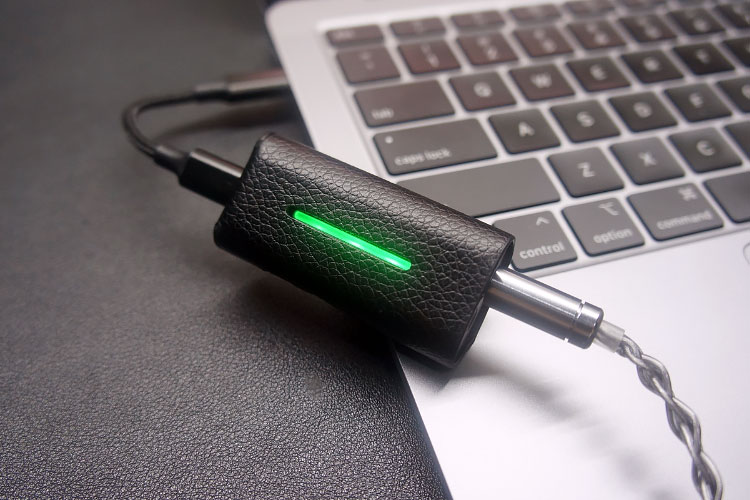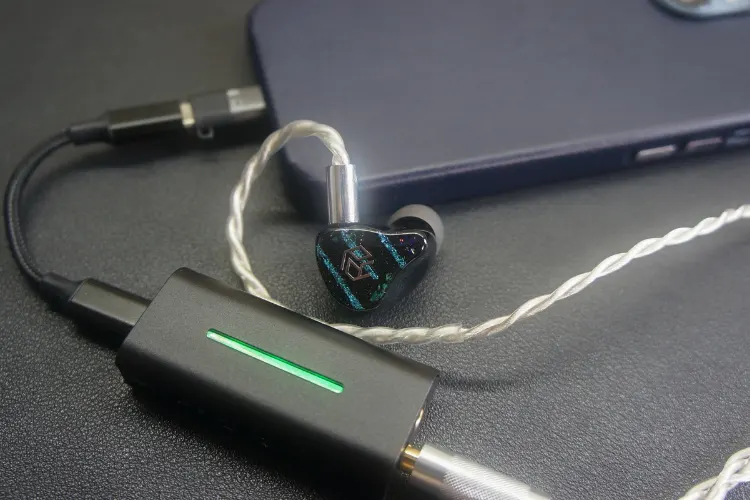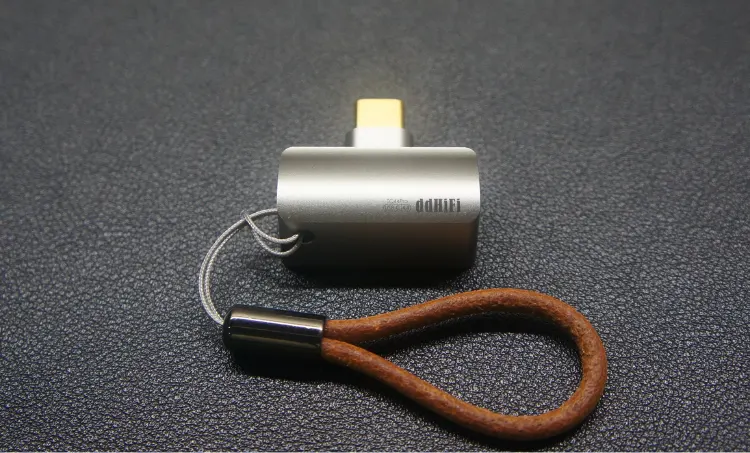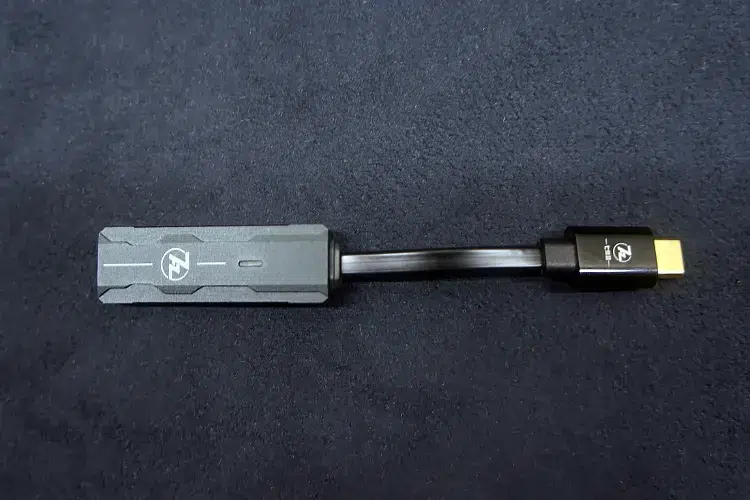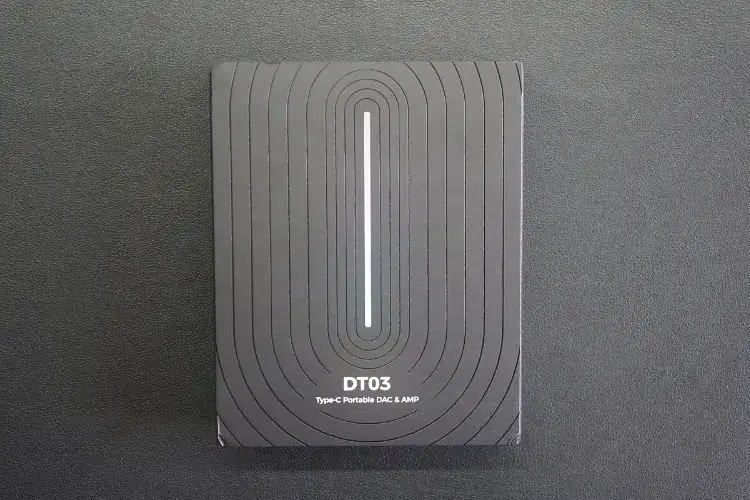Synergy
Power
The LETSHUOER DT03 shows solid output power for a dongle, delivering 195mW into 32Ω via the 4.4mm balanced output and 78mW into 32Ω through the 3.5mm single-ended output.
On its high gain setting, the single-ended output worked fine with the Tanchjim Kara and the planar magnetic Hidizs MP145.
Even compared to other dongles and desktop amplifiers in my collection, it was able to drive both the Hidizs MP145 and Kara without any compromises in technicalities.
With more demanding IEMs, such as the Moondrop Blessing 3, I noticed better instrument separation and imaging when switching from the single-ended to the balanced output.
To ensure an accurate comparison, I used the BQEYZ Winter Ultra cable with its detachable 3.5mm and 4.4mm terminations to test the DT03’s outputs.
Even when comparing the 4.4mm output on the low gain setting against the 3.5mm SE output on the high gain setting, I observed better instrument separation, especially in the mid-range.
The DT03 nearly manages to drive full-sized headphones like the HIFIMAN Ananda. It brought the Ananda to a comfortable listening level without maxing out the volume.
However, I would not recommend this pairing since I found the treble region had a distorted, metallic tonality, making it quite fatiguing for extended listening.
Its low signal-to-noise ratio makes the DT03 suitable for sensitive IEMs. Unlike other DAC/AMPs, such as the VE Megatron, I did not encounter any hissing when connecting IEMs to the 4.4mm outputs of the DT03, even on its high gain setting.
Pairings
I found that the DT03 pairs best with IEMs that have a boosted mid-range and warmer presentation as it compensates for the dongle’s overly lean tonality. Among the IEMs I tried, it paired best with the Tanchjim Kara.
The Kara’s bloat and warmth were effectively balanced by the DT03’s lean mid-bass, and since the Kara is already vocal-forward, it did not suffer much from its lack of note weight and emphasis.
However, I did not enjoy the DT03 with the Yanyin Canon II, as its V-shaped sound signature made mid-range instruments sound even more congested.
Similarly, the Moondrop Blessing 3’s stock neutral tonality was compromised by the DT03, as it diminished mid-range dynamics too much for my taste.
The DT03’s lower output and tendency to distort the treble at higher volumes also made it a poor match for the HIFIMAN Ananda. When I plugged the Ananda into a more powerful desktop amplifier, it felt like I was listening to a completely different pair of headphones.
Select Comparisons
ddHiFi TC44Pro
Technical
The TC44Pro uses dual Cirrus Logic CS43131 DAC Chips to decode up to PCM 32BIT/384kHz and DSD256, while the DT03 offers the same decoding capabilities through its dual Sabre ES9219C DAC chips.
The TC44Pro has a single input directly attached to the main PCB and body without cables, whereas the DT03 employs a detachable USB-C cable, allowing users to connect any compatible cable with their source device.
It comes with either lightning or USB-C inputs and features a 4.4mm BAL jack as its sole output. In contrast, the DT03 includes 3.5mm SE and 4.4mm BAL outputs.
The TC44Pro can output up to 120mW@32Ω through its balanced output, while the DT03 can deliver up to 195mW@32Ω through its BAL output and 78mW@32Ω through its SE output.
Design
Both dongles have different form factors, but both use CNC-machined aluminum constructions. However, the DT03 opted for a flat black color while the TC44Pro opted for a bare metal color, both colors still invoke a premium feel.
With its much larger form factor and LED indicator up front, the DT03 is immediately more attention-grabbing than the TC44Pro. Despite both dongles appearing quite sleek and stealthy.
The original TC44Pro packs all its USB-C input and 4.4mm BAL output inside one metal body without any cables sticking out. It’s light at just 9 grams and small, making it much smaller and lighter than the DT03.
The DT03’s form factor of a separate body and cable makes it harder to stay attached to a phone, but its inclusion of on-device controls makes it easier for daily use.
Performance
The TC44Pro offers a more open and spacious sound but the DT03 delivers a heavier, deeper, and fuller bass.
With jazz fusion tracks, the DT03 shines in highlighting percussive performances, especially kick drums. Its bass presentation is more textured with good decay, showcasing better articulation and mastery with percussive instruments than the TC44Pro.
It also boasts a stronger and more pronounced bass without any bass bleed into the mid-range for both devices.
The DT03 has thinner and leaner mids but excels in the upper mids and lower treble, particularly with snare drum hits and hi-hats. Male vocals on the TC44pro have a warmer, more atmospheric quality than on the DT03.
Although the DT03 lacks the vocal emphasis and emotional impact of the TC44Pro, it excels in delivering texture and emphasis in snare drum hits and hi-hat cymbals.
It outperforms the TC44Pro in percussive performances but falls short for note weight and texture of keys, horns, and string instruments.
The DT03 has a more emphasized high-end sparkle but doesn’t match the resolution of the TC44Pro. In jazz, it does a better job of highlighting percussive performances such as snares and cymbals, though it can’t achieve the same level of airiness and transparency as the TC44Pro.
7hz SEVENHERTZ 71
Technical
The DT03 uses a dual Sabre ES9219C DAC chip, while the 7Hz SEVENHERTZ 71 employs an AKM AK4377 chipset. Both dongles can decode up to PCM 32BIT/384kHz, but the DT03 can handle DSD files up to DSD256, whereas the 71 is limited to DSD128.
The 71 dongle has a USB-C male termination at the end of its attached cable and a single 3.5mm SE output. The DT03 is more versatile, with a detachable USB-C to USB-C cable that can easily be swapped out to connect to lightning or USB-A devices.
The DT03 also features both 3.5mm SE and 4.4mm BAL outputs. It can output up to 195mW@32Ω through its BAL output and 78mW@32Ω through its SE output, while the 71 can provide up to 70mW@32Ω.
Design
The 71’s body is made from a lightweight anodized black aluminum shell with geometric edges breaking an otherwise basic silhouette. It is also much smaller in size compared to the DT03.
The DT03’s larger build houses a more comprehensive set of I/O, as well as more user-friendly controls, including physical volume controls, which the 71 lacks.
The 71, on the other hand, feels like an extension of the IEM cable when used on the go, while the DT03 feels like it wants to be nestled right behind the source device or within a pocket.
Performance
The low-end notes on the 7hz 71 had a lot more warmth and body compared to the DT03,. Bass hits from the kick drums had a more brutal slam or thump through the 71 but were not as resolving or textured compared to what the DT03 could reproduce.
It’s worth noting that the bass from the 71 did bleed into the mids, contributing to a stronger perception of a slight veil in the general presentation.
The mids performance of the two dongles was a mixed bag. The DT03 was able to play mid-range tones with more resolution, however, the 71’s warmer tonality made these instruments sound more musical and pleasing.
Male vocals sounded much more authoritative through the 71, while they felt relatively flat on the DT03, albeit with a little more detail.
The 71 had less energetic and airy treble. The hi-hats and crash cymbals were played back with more sparkle and resolution through the DT03, giving the overall sound signature more headroom.
Kiwi Ears Allegro
Technical
The Allegro is equipped with an older Sabre ES9028Q2M DAC chip as opposed to ES9219C. However, both dongles have identical decoding capabilities, supporting PCM up to 32BIT/384kHz and DSD up to DSD256.
Both dongles feature a removable USB-C female jack, allowing users to swap out the cable for one compatible with their source device.
Additionally, both units include a 3.5mm SE jack and a 4.4mm BAL jack. The Allegro can deliver up to 155mW@32Ω and 70mW@32Ω through its balanced output, while the more powerful DT03 can drive up to 195mW@32Ω and 78mW@32Ω.
Design
The DT03 is constructed out of black-colored aluminum in the shape of a curved rectangular prism that is longer but thinner than the Allegro, with its game-controller-inspired design.
The Allegro immediately stands out, appearing as a geek-culture-inspired piece of jewelry, while the DT03 looks sleeker with a design philosophy that fits in most EDCs
Performance
The low-end bass drum response is notably stronger and more textured with the DT03 than with the Allegro. While the Allegro also presents good percussive texture, it does not have the same emphasis and refinement as the DT03.
In songs with deep bass lines and lush synth backgrounds, the Allegro has a pleasant warmth that the DT03 lacks. Rhythmic bass lines hold more heft and authority on the Allegro.
The Allegro is more vocal and midrange-forward providing a more open midrange presentation. Vocals are richer with micro-detail and emotion through the Allegro.
Instrument and vocal layering sound audibly better on the Allegro, offering superior separation and detail for horns and string instruments in complex jazz fusion pieces.
The treble region of the Allegro sounds slightly veiled and muffled compared to the DT03. The DT03 offers higher resolution, with cymbals and snare hits exhibiting more shine and articulated decay.
However, the Allegro has a fatiguing emphasis on snares and hi-hats, a characteristic not shared by the DT03.
Our Verdict
The LETSHUOER DT03 is a competitive proposition within the Dongle DAC market. With a versatile set of I/O and controls for a dongle, on paper, it’s an all-in-one unit perfect for everyday use.
However, its lean mid-range presentation and dynamics means finding a pair of IEMs to pair with it is essential for an enjoyable listening experience.
With respectable power output on both its 3.5mm SE and 4.4mm BAL jacks, it has enough on-paper specifications to cater to budget and mid-fi IEMs through multiple upgrades, however, I found its sound signature compliments warmer IEMs with a boost within the vocal and mid-range.
With its reliance on a good IEM pairing, the DT03 is not for everyone. But if its leaner tonality aligns with your listening preferences, it provides a good value with its versatility and ease of use.
LETSHUOER DT03 Technical Specifications
- DAC Chips: Dual Sabre ES9219C DACs
- Output(s): 3.5mm Single Ended and 4.4mm Balanced
- THD+N <0.0006% (4.4mm BAL)
- Output Power: 78mW @32Ω(SE) and 195mW@32Ω (BAL)

